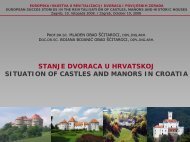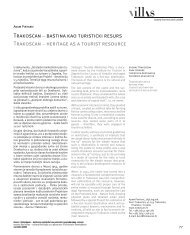Ime i prezime autora (sa titulama) - Dvorci.hr
Ime i prezime autora (sa titulama) - Dvorci.hr
Ime i prezime autora (sa titulama) - Dvorci.hr
You also want an ePaper? Increase the reach of your titles
YUMPU automatically turns print PDFs into web optimized ePapers that Google loves.
Northern Croatia – Their State and Possibilities for Inclusion into Modern Life, Zagreb, Republičkizavod za zaštitu spomenika kulture SRH4. In the study Manors and Curiae of Northern Croatia (1970) manors were grouped into fivecategories based on their monument value: of international significance (0), of significance forYugoslavia (1), of national significance (2), of regional significance (3), of local significance (4) andof ambient significance (5). This categori<strong>sa</strong>tion was adopted as early as 1967.5. The 1967 categori<strong>sa</strong>tion of manors was based on the following criteria:The zero (0) category was comprised of monuments of the highest cultural-artistic, historical andscientific value recognizable on the European/global level.The first (1) category was comprised of monuments of unique, representative or significantdevelopment characteristics from the cultural-artistic, historical and scientific point of view, at thattime on the territory of the former country; today this significance could be determined for southeasternEurope (the Balkans).The second (2) category was comprised of monuments of unique, representative and developmentsignificance with cultural-artistic, historical and scientific values from the territory of Croatia (it ispossible to include those altered buildings which have preserved most of their original features andcontents). The building's present state was not of importance for inclusion in the zero, first andsecond category (meaning that a ruin could also be classified as a cultural monument of zerocategory).The third (3) category was comprised of monuments holding significance for a specific region andpossessing certain artistic, historical and scientific significance and which as such had become arecognizable element in the environment.The fourth (4) category was comprised of monuments of average or lesser cultural-artistic,historical and scientific value, important for a narrow local area (monuments which by their valuebelonged to a higher category, but whose original appearance had been changed to a high degreeor was preserved only in details also belonged to this category).The fifth (5) category was comprised of buildings and structures of minimal cultural-artistic,historical and scientific value but which, when regarded as a whole, contributed to the value of acertain environment.6. Uputa za vrjednovanje kulturnih dobara predloženih za upis u Registar kulturnih dobaraRepublike Hrvatske / The Instruction Book for Evaluation of Cultural Goods Recommended forInscription into the Register of Cultural Goods of the Republic of Croatia, Ministarstvo kulture RH,kla<strong>sa</strong>: 612-08/04-01-06/03, urbroj: 532-10-1/8(JB)-5, Zagreb, 21.05.2004.7. According to the Instruction Book, CHARACTERISTICS OF A CULTURAL GOOD are establishedon the basis of originality, rarity, representativeness, diversity, integrality as well as ambient andaesthetic-artistic value. ORIGINALITY implies the existence of original (primary) elements of thebuilding and the environment. RARITY presupposes uniqueness or existence of a very smallnumber of buildings or construction and environmental elements. REPRESENTATIVENESS isdetermined on the basis of being unique of its kind, being restricted to a certain area or time periodor having typical or specific forms. DIVERSITY manifests in the richness of structures, forms,processes and contents. INTEGRALITY can be seen in preserved functions and forms of the culturalgood. AMBIENT or LANDSCAPE VALUE is manifested as the degree of attractiveness and generalinfluence of the particular cultural good on human environment. AESTHETIC-ARTISTIC VALUE ismanifested as the presence of widely accepted artistic or aesthetic characteristics.8. According to the Instruction Book, SIGNIFICANCE AND FUNCTION of a cultural good areassessed in relation to the good’s scientific, cultural and educational importance and manifest asthe possibility for researching, presenting, using and nurturing values of a cultural good to theextent that would not affect its characteristics as a cultural good.9. According to the Instruction Book, THE TIME OF CONSTRUCTION is evaluated with regard tothe good’s age and duration as well as with regard to its state of preservation in comparison withthe original state.10. According to the Instruction Book, SPECIAL CRITERIA refer to immovable cultural goods, thatis, to construction heritage. Based upon the fundamental criteria (characteristics, significance andfunction, time of origin), valori<strong>sa</strong>tion included the function, form, materials, environment,14





